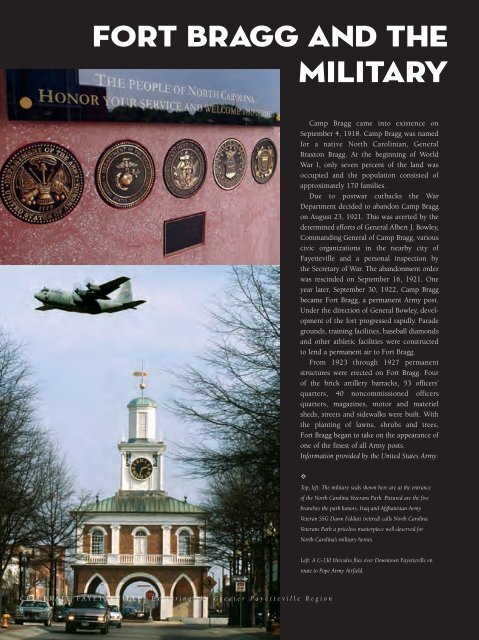Celebrate Fayetteville: Exploring the Greater Fayetteville Region
A full-color photography book showcasing Fayetteville, NC area, paired with the histories of companies, institutions, and organizations that have made the region great.
A full-color photography book showcasing Fayetteville, NC area, paired with the histories of companies, institutions, and organizations that have made the region great.
Create successful ePaper yourself
Turn your PDF publications into a flip-book with our unique Google optimized e-Paper software.
Camp Bragg came into existence on<br />
September 4, 1918. Camp Bragg was named<br />
for a native North Carolinian, General<br />
Braxton Bragg. At <strong>the</strong> beginning of World<br />
War I, only seven percent of <strong>the</strong> land was<br />
occupied and <strong>the</strong> population consisted of<br />
approximately 170 families.<br />
Due to postwar cutbacks <strong>the</strong> War<br />
Department decided to abandon Camp Bragg<br />
on August 23, 1921. This was averted by <strong>the</strong><br />
determined efforts of General Albert J. Bowley,<br />
Commanding General of Camp Bragg, various<br />
civic organizations in <strong>the</strong> nearby city of<br />
<strong>Fayetteville</strong> and a personal inspection by<br />
<strong>the</strong> Secretary of War. The abandonment order<br />
was rescinded on September 16, 1921. One<br />
year later, September 30, 1922, Camp Bragg<br />
became Fort Bragg, a permanent Army post.<br />
Under <strong>the</strong> direction of General Bowley, development<br />
of <strong>the</strong> fort progressed rapidly. Parade<br />
grounds, training facilities, baseball diamonds<br />
and o<strong>the</strong>r athletic facilities were constructed<br />
to lend a permanent air to Fort Bragg.<br />
From 1923 through 1927 permanent<br />
structures were erected on Fort Bragg. Four<br />
of <strong>the</strong> brick artillery barracks, 53 officers’<br />
quarters, 40 noncommissioned officers<br />
quarters, magazines, motor and materiel<br />
sheds, streets and sidewalks were built. With<br />
<strong>the</strong> planting of lawns, shrubs and trees,<br />
Fort Bragg began to take on <strong>the</strong> appearance of<br />
one of <strong>the</strong> finest of all Army posts.<br />
Information provided by <strong>the</strong> United States Army.<br />
✧<br />
Top, left: The military seals shown here are at <strong>the</strong> entrance<br />
of <strong>the</strong> North Carolina Veterans Park. Pictured are <strong>the</strong> five<br />
branches <strong>the</strong> park honors. Iraq and Afghanistan Army<br />
Veteran SSG Dawn Falduti (retired) calls North Carolina<br />
Veterans Park a priceless masterpiece well-deserved for<br />
North Carolina’s military heroes.<br />
Left: A C-130 Hercules flies over Downtown <strong>Fayetteville</strong> en<br />
route to Pope Army Airfield.<br />
C E L E B R A T E F A Y E T T E V I L L E : E x p l o r i n g t h e G r e a t e r F a y e t t e v i l l e R e g i o n<br />
8
















